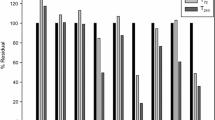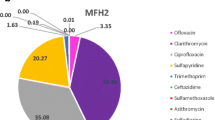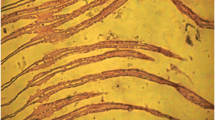Abstract
Hospital wastewaters contain large amounts of pharmaceutical residues, which may eventually be discharged into the aquatic environment through wastewater treatment plants, raising the question of their impact on human and environmental health. This has prompted the launch of several monitoring studies into the most commonly administered compounds in urban wastewater. The aim of this study was, therefore, to explore the cytotoxic potential of wastewaters samples collected from seven hospitals in Tunisia. The physicochemical analyses showed a large fluctuation of certain parameters in the collected samples, such as chemical oxygen demand (ranged from 860 to 1720 mg L−1), biochemical oxygen demand (ranged from 385 to 747 mg L−1), total organic carbon (ranged from 256 to 562 g L−1), total suspended solids (ranged from 905 to 1450 mg L−1), conductivity (ranged from 3.31 to 7.14 μsm/cm), and turbidity (ranged from 100 to 480 NTU). The analysis using inductively coupled plasma mass spectrometry (ICP-MS) also showed that hospital wastewater contains high concentrations of Hg (ranged from 0.0024 to 0.019 mg L−1). This could be explained by the variation of the activity and the services in certain hospitals compared to others. All hospital wastewater samples induced the proliferation of human breast cancer cell line MDA-231, even at low concentrations (20 μL/assay). Moreover, the maximum induction reached at the concentration of 60 μL/assay in wastewater samples from hospitals located in Monastir, Sidi Bouzid, Mahdia, and Sfax with percentages of induction up to 42.33, 14, 7.61, and 5.42%, respectively. These observations could be due to the presence of endocrine disrupting compounds (EDCs) in these wastewaters. Given this, our results evidenced the potential risk of these hospital effluents to environmental and public health.

Similar content being viewed by others
Explore related subjects
Discover the latest articles and news from researchers in related subjects, suggested using machine learning.References
Akin BS (2016) Contaminant properties of hospital clinical laboratory wastewater: a physiochemical and microbiological assessment. Environ Prot 7:635–642
Aquino NB, Sevigny MB, Sabangan J, Louie MC (2012) Role of cadmium and nickel in estrogen receptor signaling and breastcancer. Metalloestrogen or not ? J Environ Sci Health C Environ Carcinog Ecotoxicol Rev 30:189–224
Barcelo D, Barceló D (2003) Emerging pollutants in water analysis. TrAC. Trends Analytical Chem 22
Bartucci M, Morelli C, Mauro L, Ando S, Surmacz E (2001) Differential insulin-like growth factor I receptor signaling and function in estrogen receptor (ER)-positive MCF-7 and ER-negative MDA-MB-231 breast cancer cells. Cancer Res 61:6747–6754
Boillot C, Bazin C, Tissot-Guerraz F, Droguet J, Perraud M, Cetre JC (2008) Daily physicochemical, microbiological and ecotoxicological fluctuations of a hospital effluent according to technical and care activities. Sci Total Environ 403:113–129
Cailleau RM, Young R, Olive M, Reeves WJ (1974) Breast tumor cell lines from pleural effusions. J Natl Cancer Inst 53:661–674
D’Ascenzo G, Di Corcia A, Gentili A, Mancini R, Mastropasqua R, Nazzari M, Samperi R (2003) Fate of natural estrogen conjugates in municipal sewage transport and treatment facilities. Sci Total Environ 302:199–209
Daughton CG, Ternes TA (1999) Pharmaceuticals and personal care products in the environment: agents of subtle change. Environ Health Perspect:907–938
David A, Fenet H, Gomez E (2009) Alkylphenols in marine environments: distribution monitoring strategies and detection considerations. Mar Pollut Bull 58:953–960
El Tahiri M, Nejjari C, Benaabidate L, Benbrahim KF (2009) Caractérisation des effluents liquides de l’hôpital Al Ghassani, CHU Hassan II de Fès, Maroc Les effluents Liquides des établissements de santé : état des Lieux et perspectives de gestion Revue hospitalière de France TH 714
Emmanuel E (2004) Évaluation des risques sanitaires et écotoxicologiques liés aux effluents hospitaliers. Thèse INSA de Lyon – Spécialité Sciences et Techniques du Déchet 259
Hartemann P, Hautemaniere A, Joyeux M (2005) La problématique des effluents hospitaliers. Hygiène 369–374
Hye R, Kyung A, Min A, Bo R, Eui B, Kyung C (2012) Treatment with bisphenol A and methoxychlor results in the growth of human breast cancer cells and alteration of the expression of cell cycle-related genes, cyclin D1 and p21,via an estrogen receptor-dependent signaling pathway. Int J Mol Med 29:883–890
Jebri S, Jofre J, Barkallah I, Saidi M, Hmaied F (2012) Presence and fate of 492 coliphages and enteric viruses in three wastewater treatment plants effluents and 493 activated sludge from Tunisia. Environ Sci Pollut Res Int 19:2195–2201
Jobling S, Coey S, Whitmore JG, Kime DE, Van Look KJW, McAllister BG (2002) Wild intersex roach (Rutilusrutilus) have reduced fertility. Biol Reprod 67:515–524
Kümmerer K (2001) Drugs in the environment: emission of drugs, diagnostic aids and disinfectants into wastewater by hospitals in relation to other sources—a review. Chemosphere 45:957–969
Lange R, Hutchinson TH, Croudace CP, Siegmund F, Schweinfuryh H, Hampe P, Panter GH, Sumpter JP (2001) Effects of the synthetic estrogen 17 alpha-ethinylestradiol on the lifecycle of the fathead minnow (Pimephalespromelas). Environ Toxicol Chem 20:1216–1227
Lippman M, Bolan G, Huff K (2014) The effects of glucocorticoids and progesterone on hormone responsive human breast cancer in long-term tissue culture. Cancer Res 36:4602–4609
Liscio C, Magi E, Carro MD, Suter MJF, Vermeirssen ELM (2009) Combining passive samplers and biomonitors to evaluate endocrine disrupting compounds in a wastewater treatment plant by LC/MS/MS and bioassay analyses. Environ Pollut 157:2716–2721
Luparello C, Longo A, Vetrano M (2010) Exposure to cadmium chloride influences astrocyte-elevated gene-1 (AG-1) expression in MDA–MB231 human breast cancer cells. Biochemical 94:207–213
Metcalf E (2003) Wastewater engineering: treatment and reuse. In: G. Tchobanoglous, F.L. Burton, H.D. Stensel (eds) New York 969
Mnif W, Dagnino S, Escande A, Pillon A, Fenet H, Gomez E, Casellas C, Duchesne MJ, Hernandez-Raquet G, Cavailles V, Balaguer P, Bartegi A (2010) Biological analysis of endocrine-disrupting compounds in Tunisian sewage treatment plants. Arch Environ Contam Toxicol 59:1–12
Mnif W, Ibn HadjHassine A, Zidi I, Dagnino S, Bouaziz A, Fenet H, Haj Hamouda Y, Balaguer P, Bartegi A (2011) Occurrence of estrogenic and pregnane X receptor specific activities in Tunisian sewage treatment plants using a panel of bioassays. Immunoanalysebiologiespécialisée 26:1–5
Ohlsen K, Ternes T, Werner G, Wallner U, Loffler D, Ziebuhr W, Witte W, Hacker J (2003) Impact of antibiotics on conjugational resistance gene transfer in Staphylococcus aureus in sewage. Environ Microbiol 5:711–716
Panjehpour M, Thaher MA, Bayesteh M (2010) The growth inhibitory effect of cadmium and copper on the MDA-MB468 human breast cancer cells. J Res Med Sci 15:279–286
Perry RR, Kang Y, Greaves BR (1995) Greaves relationship between tamoxifen-induced transforming growth factor Pi3 expression, cytostasis and apoptosis in human breast cancer cells. Br J Cancer 72:1441–1446
Phillips KP, Foster WG (2008) Key developments in endocrine disrupter research and human health. J Toxicol Environ Health B 11:322–344
Sdiri-Loulizi K, Hassine M, Aouni Z, Gharbi-Khelifi H, Chouchane S, Sakly N, Neji-Guédiche M, Pothier P, Aouni M, Ambert-Balay K (2010) Detection and 496 molecular characterization of enteric viruses in environmental samples in Monastir, 497 Tunisia between January 2003 and April 2007. J Appl Microbiol 109:1093–1104
Senaratne SG, Pirianov G, Mansi JL, Arnett TR, Colston KW (2000) Bisphosphonates induce apoptosis in human breast cancer cell lines. Br J Cancer 82:1459–1468
Toyama T, Shinkai Y, Yasutake A, Uchida K, Yamamoto M, Kumagai Y (2011) Isothiocyanates reduce mercury accumulation via an Nrf2-dependant mechanism during exposure of miceto methylmercury. Environ Health Perspect 119:1117–1112
Verlecar XN, Jena KB, Chainy GB (2008) Modulation of antioxidant in digestive gland of Perna viridis (L.), on mercury exposures. Chemosphere 71:1977–1985
Verlicchi P, Galletti A, Petrovic M, Barceló D (2010) Hospital effluents as a source of emerging pollutants: an overview of micropollutants and sustainable treatment options. J Hydrol 389:416–428
Author information
Authors and Affiliations
Corresponding author
Additional information
Responsible editor: Philippe Garrigues
Rights and permissions
About this article
Cite this article
Nasri, E., Machreki, M., Beltifa, A. et al. Cytotoxic effects of seven Tunisian hospital wastewaters on the proliferation of human breast cancer cell line MDA-231: correlation with their chemical characterization. Environ Sci Pollut Res 24, 20422–20428 (2017). https://doi.org/10.1007/s11356-017-9717-7
Received:
Accepted:
Published:
Issue Date:
DOI: https://doi.org/10.1007/s11356-017-9717-7
Keywords
Profiles
- Hedi Ben Mansour View author profile




